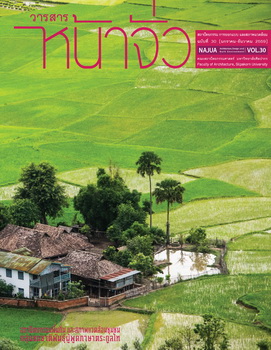โครงการศึกษาแนวทางการจัดทำที่อยู่อาศัยสำหรับผู้มีรายได้น้อยในเขตเมืองด้วยวิธีการจัดรูปที่ดิน
คำสำคัญ:
ผู้มีรายได้น้อย, เขตเมือง, การจัดรูปที่ดิน, การปันส่วนที่ดิน, low income people, urban area, land readjustment, land contributionบทคัดย่อ
บทความวิจัยนี้เล็งเห็นถึงปัญหาของพื้นที่เมืองที่ขาดการฟื้นฟูและการพัฒนาปล่อยให้เป็นพื้นที่ว่างเปล่า รกร้าง เสื่อมโทรม อันอาจเป็นภัยสังคมและผลต่อสภาพแวดล้อมของเมืองในทางลบ ด้วยพื้นที่เหล่านั้นขาดโอกาสในการเข้าถึง ทำให้เป็นอุปสรรคในการพัฒนา ทั้งที่มีศักยภาพต่อการพัฒนาให้สอดคล้องกับสภาพเศรษฐกิจ และสังคมนั้นได้ จึงเป็นวัตถุประสงค์ของการวิจัยเพื่อศึกษานำวิธีการจัดรูปที่ดินมาใช้เป็นเครื่องมือในการพัฒนาพื้นที่ให้เป็นที่อยู่อาศัยสำหรับผู้มีรายได้น้อยในเขตเมือง โดยผลการศึกษาแบ่งเป็น 3 ส่วน ส่วนแรกคือ การจัดหาพื้นที่เมือง เพื่อนำมาพัฒนาที่อยู่อาศัยสำหรับผู้มีรายได้น้อย ด้วยวิธีการจัดรูปที่ดินโดยไดพื้นที่บริเวณถนนพระราม 2 เขตบางขุนเทียน กรุงเทพฯ มีพื้นที่ 141-0-14 ไร่ 7 แปลงที่ดิน 19 ราย ผู้ถือกรรมสิทธิ์ที่ดิน ส่วนที่สองคือ การเสนอแนะการวางผังจัดรูปที่ดินแปลงใหม่พร้อมการพัฒนา ในพื้นที่จัดหาประโยชน์ โดยมีอัตราปันส่วนที่ดินเพื่อเป็นพื้นที่สาธารณะ 14-3-62 ไร่ (10.57% ของพื้นที่โครงการ) และพื้นที่จัดหาประโยชน์ 8-0-14 ไร่ (5.75% ของพื้นที่โครงการ) ส่วนสุดท้ายคือ การเสนอแนะภาพรวมของการนำผังไปสู่การปฏิบัติ โดยเสนอให้การเคหะแห่งชาติเป็นผู้ดำเนินโครงการ และพัฒนาพื้นที่สาธารณะ (ถนน ระบบสาธารณูปโภคและสวน) และเชิญชวนให้ภาคเอกชนร่วมลงทุนในพื้นที่จัดหาประโยชน์พัฒนาเพื่อที่อยู่อาศัยสำหรับผู้มีรายได้น้อย
ผลสรุป จากการวางผังจัดรูปแปลงที่ดินใหม่คาดว่าที่ดินทั้ง 7 แปลงจะมีถนนเข้า-ออกที่สะดวกและมีรูปแปลงที่ดินที่สวยงาม เป็นระเบียบ มีระบบสาธารณูปโภค สวน อย่างครบถ้วนและได้มาตรฐาน พัฒนาพื้นที่จัดหาประโยชน์ให้เป็นชุมชนพักอาศัยสำหรับผู้มีรายได้น้อยและสร้างโอกาสในการพัฒนาที่ดินแปลงอื่นๆ ต่อไป ก่อให้เกิดมูลค่าที่ดินเพิ่มขึ้นจากราคาที่ดินเดิม 100-150% เปลี่ยนจากสภาพเดิมที่เป็นพื้นที่รกร้างและเสื่อมโทรม
Development of Low-Income Housing Project in Urban Areas Using Land Readjustment Method
Somsarit Tanapant
Faculty of Architecture, Rangsit University
This paper deals with the problems of neglected urban areas and the lack of attention and development, which left the lands vacant and deteriorated. Such condition may endanger society and have negative consequencs on the urban environment. The difficulty in accessing these areas is an obstacle for development despite their potential in view of economic and social opportunities. Thus, the purpose of this study was to examine how land readjustment method can be used as a tool to develop such areas into housing for low-income people in urban areas. The study was carried out in three parts. First, a site suitable for low-income housing development and land readjustment was selected. Located on Rama 2 Road in Bang Kun Thian, Bangkok, the site comprises 7 plots of land belonging to 19 owners and has a total area of 141-0-14 rais. Second, a new master plan and development proposals were made whereby 14-3-62 rais (10.57 % of the total area) had been allocated for public amenities, and 8-0-14 rais (5.75 % of the total area) for concession purposes that would bring in additional revenue. Third, an overall strategy for implementation of the new master plan is proposed and suggestions made for the National Housing Authority (NHA) to undertake the project, develop public amenities such as roads, parks, infrastructure, and call for the private sector to invest in the development of the concession areas into housing for low-income people.
In conclusion, according to the new master plan under land readjustment, it is expected that all 7 plots of land would be conveniently accessible by road, beautifully arranged and subdivided, complete with parks and up-to-standard public amenities. The concession areas can be developed into a residential community for low-income people and open up the opportunity for other plots of land to develop. In turn, the transformation from wild, abandoned and deteriorated area into an improved environment could also increase the land value by 100-150 percent.





